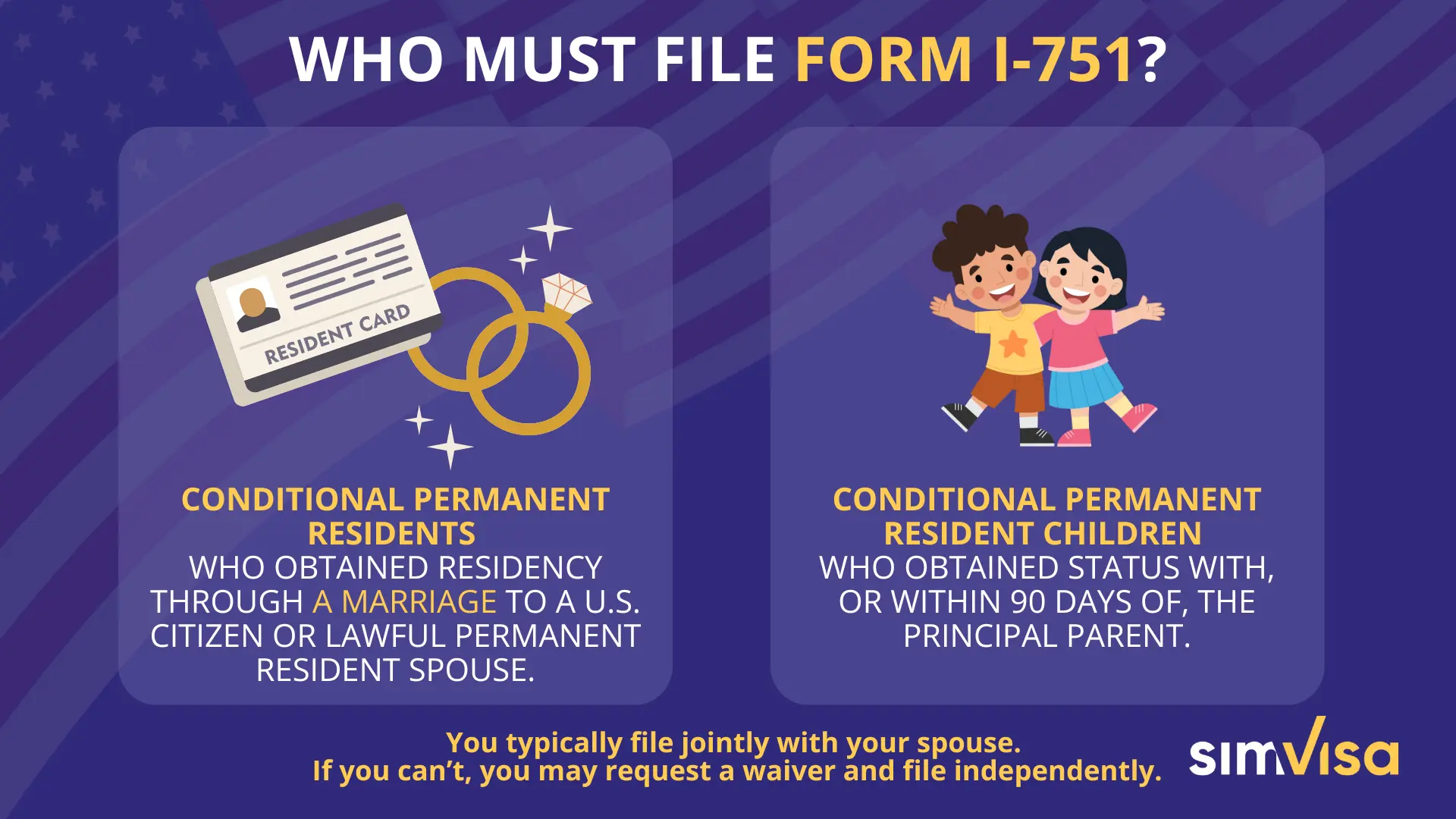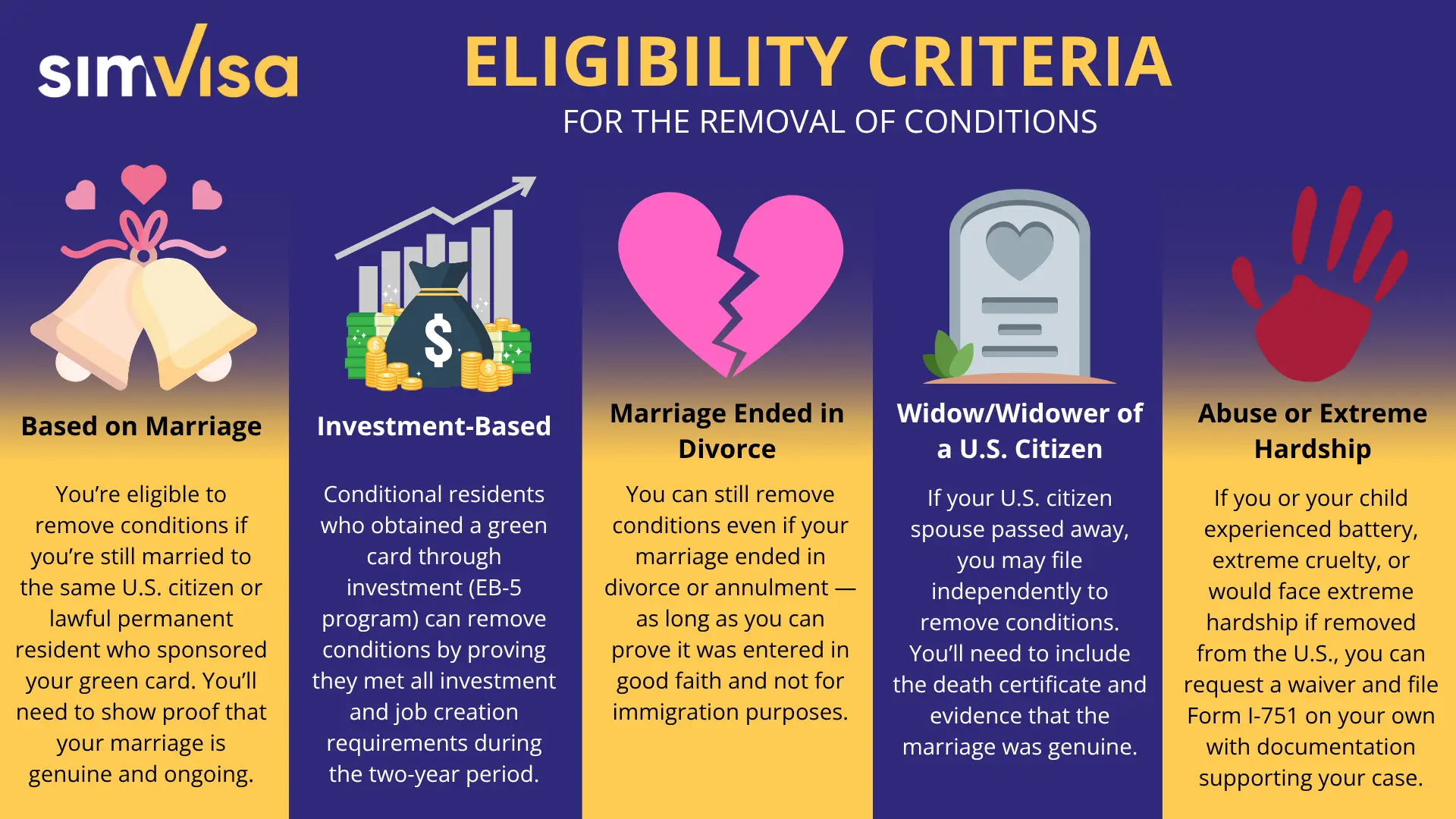If you received a conditional green card after getting married, you’re a conditional permanent resident for two years. To keep your lawful permanent resident status, you must file USCIS Form I-751.
The skilled removal of conditions lawyers at SimVisa are here to provide you with a roadmap to what lies ahead. This guide will explain who must file and when, how to request a waiver of the joint filing requirement, what supporting evidence to include, how to handle late filings, and what to expect after you submit.
What “Conditional” Really Means
A two-year conditional resident status is issued when a marriage to a U.S. citizen or lawful permanent resident was less than two years old on the day the subject became a resident. This status is temporary and is designed to confirm that the marriage is bona fide, or entered in good faith, rather than for immigration purposes.
- Your goal: Convert conditional residence to full permanent resident status (a 10-year green card).
- Your tool: Form I-751, Petition to Remove Conditions on Residence.
- Your deadline: The 90-day window before your conditional green card expires.
If your conditional residence expires and you do nothing, you risk losing your status and facing removal proceedings. It’s therefore important to file on time or provide an explanation of why you couldn’t.
Note: This guide is for marriage-based cases. If you got your green card through investment, you'll need to file Form I-829 instead.
Who Qualifies for Removal of Conditions?

You qualify to remove conditions on your green card if you received a two-year conditional green card through marriage to a U.S. citizen or lawful permanent resident. To stay in the U.S. as a lawful permanent resident, you must file Form I-751 before your conditional green card expires.
Basic Eligibility
You can file if:
- You’re a conditional permanent resident with a valid two-year card.
- You take action within 90 days before your card expires (or explain filing late).
- You can prove that your marriage was entered in good faith.
Conditional Resident Children
Any children who became conditional permanent residents at the same time as you (or within 90 days) can be included in your petition. Others must file separately.
What to Do If You’re Unsure
If your situation involves divorce, abuse, late filing, or criminal records, talk to an immigration attorney before filing. They can help verify your eligibility and explain how to structure your Form I-751 and supporting evidence for the best outcome.
Filing Jointly or Alone

You and your spouse will have to file together, showing proof of a continuing, bona fide marriage through joint tax returns, bank statements, a lease or mortgage, and your children’s birth certificates (if applicable).
However, if filing jointly isn't possible, you may request a waiver and file without your spouse if any of the following apply:
- Marriage ended: Make sure to attach your final divorce or annulment decree.
- Death of spouse: Furnish proof of marriage and your spouse’s death certificate.
- Battery or extreme cruelty: Include records such as police reports, protection orders, medical records, school or work reports, photos, and affidavits.
- Extreme hardship: Provide proof that removal would cause you extreme hardship, such as conditions in your home country, health issues, finances, or family ties.
You can check multiple waiver boxes if more than one applies. The key is to offer substantial evidence for the circumstances you’re claiming.
Joint filers must submit their materials during the 90-day window before the card expires, while individuals seeking waivers may file at any time after becoming a conditional resident.
What Evidence Should You Provide?
USCIS will look for proof that your marriage is ongoing and bona fide. Here’s how to give it to them:
Core Evidence
- Joint tax returns or IRS tax transcripts (last two to three years).
- Joint bank statements and credit cards (showing activity over time, not a single month).
- Mortgage documents or lease bearing both spouses’ names.
- Utility, phone, and insurance policies listing both spouses.
- Children’s birth certificates or adoption records.
Additional Evidence
- Retirement/beneficiary designations, wills, life insurance, or health insurance enrollment.
- Vehicle titles/loans or major purchases in both names.
- Photos spanning seasons and depicting special occasions with the spouse's family and friends.
- Affidavits from people who can attest to your marital relationship (include full contact info).
- Travel records, boarding passes, and hotel bookings showing trips together.
- Mail to the same current address over time.
Foreign language materials will need to undergo a certified English translation. Always submit copies unless USCIS requests originals.
How to File Your Form I-751 Petition (Step by Step)
- Choose your filing basis: Joint filing or waiver (or both, if applicable).
- Complete Form I-751: Use the latest edition, fill in every field that applies, and sign in ink if mailing.
- Assemble your packet:
- Form I-751 petition.
- Filing fees (see USCIS fee schedule for up-to-date fees).
- Supporting evidence (organized by category and date).
- Your children’s evidence and status details (if applicable).
- Detailed explanation and proof of conditions if filing a waiver.
- File by mail:
- Use the correct lockbox address per USCIS.
- At the time of writing, you cannot file Form I-751 online; however, you can track case updates, respond to RFEs, and receive notices electronically.
- After filing:
- Await your receipt notice (Form I-797C).
- Attend a biometrics appointment if scheduled (often reused from past cases).
- Respond to any requests for evidence (RFEs) by the deadline.
- Watch for your scheduled interview or direct approval.
2025 Updates You Should Know

Receipt Notice Extends Your Card for 48 Months
After you file, your I-797C receipt notice will extend your residency card for 48 months past the printed expiration date. Make sure to carry the receipt notice with your expired card; together, they prove employment and reentry eligibility while your case is pending.
It’s Common to Reuse Biometrics Data
Many conditional residents won’t be scheduled for a new biometrics appointment, so don’t panic if your case status stays at “Case Was Received” for a while.
Interviews Are Discretionary
Providing strong, consistent documentation can get the interview requirement waived. Red flags, such as thin evidence, inconsistent answers, or criminal issues, tend to trigger an in-person interview (sometimes a Stokes interview for more detailed questioning).
Processing Time and What Happens Next

- Processing time: Varies by service center and circumstantial facts; expect your case to take many months.
- Status timeline:
- Receipt notice (48-month extension).
- Biometrics appointment (or reuse).
- Request for evidence (if needed)Interview (if required).
- Approval and issuing of your permanent green card (valid for 10 years).
Keep your address updated with USCIS to avoid lost notices or cards.
If You Move, Travel, or Work While Your I-751 Is Pending
- Travel: Carry your expired card plus your I-797C receipt and a valid passport.
- Employment eligibility (I-9): Your expired permanent resident card and 48-month receipt notice are acceptable.
- Change of address: File Form AR-11 promptly so you don’t miss an appointment notice.
If You’re Filing Late (or Already in Proceedings)

If you’re filing late, make sure to include a letter providing a valid reason (such as medical issues, abuse, severe hardship, or counsel error) and supporting evidence.
If removal proceedings are already underway, you can still file or continue your I-751 and present the petition and evidence to the court. You’ll need to work closely with an immigration attorney to improve your chances of success.
Common Mistakes and Fixes
Some of the filing mistakes applicants most frequently make:
- Waiting too long: Don’t miss the 90-day filing window. If you do, include a solid explanation as to why.
- Providing insufficient evidence: One bank statement won’t cut it. You must satisfactorily show continuity of the marital relationship.
- Failing to organize the packet: Label sections clearly (e.g., “2013–2025 Joint Bank Statements”) so the officer reviewing your information can verify quickly.
- Forgoing translation: Any foreign language documents will need to undergo a certified English translation.
- Not making important updates: If your situation changes (e.g., new address, termination of marriage), update USCIS and adjust your filing basis right away.
How Working with an Immigration Attorney Can Make All the Difference
A well-prepared Form I-751 petition with substantial evidence of a bona fide marriage often makes for a smoother path — in some cases, an interview may not even be necessary. If the facts of your case are complicated, an experienced immigration attorney can help you demonstrate your eligibility, organize your documents, and avoid preventable delays.
If at any point you start to feel lost, the compassionate legal advocates at SimVisa are here to lend a helping hand. Contact us today to make your dreams of a condition-free green card a reality.
Frequently Asked Questions
Do I have to file jointly if my spouse and I are separated or divorcing?
You can request a waiver and file independently if the marriage has ended or if you qualify under the domestic violence or extreme hardship categories. Provide evidence of your good-faith marriage and the final divorce decree when available.
Can my child be included on my I-751?
Yes, if your conditional permanent resident children obtained their status at the same time you did or within 90 days. Otherwise, you must submit a separate I-751 for each child.
What if I’m asked for more documents?
Respond to any requests for evidence exactly as directed. Include additional evidence that fills the gaps, such as more recent financial records, updated mortgage documents, or joint tax returns.
How much are the filing fees?
USCIS updates its filing fees periodically. Always check the current amount on the USCIS fee schedule (Form G-1055) before you pay.











